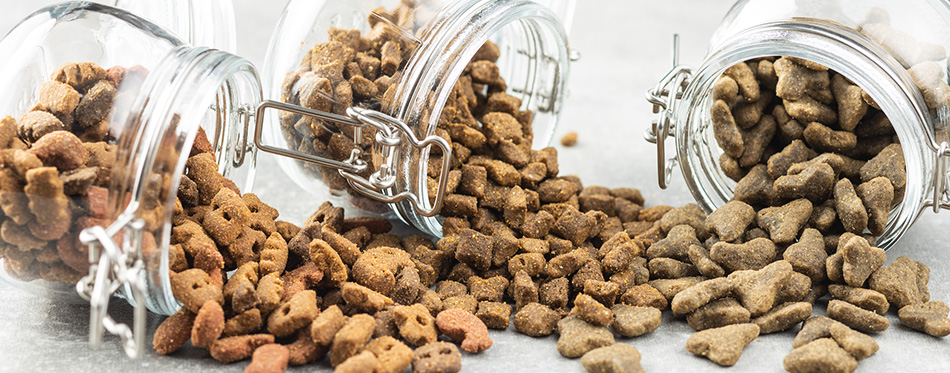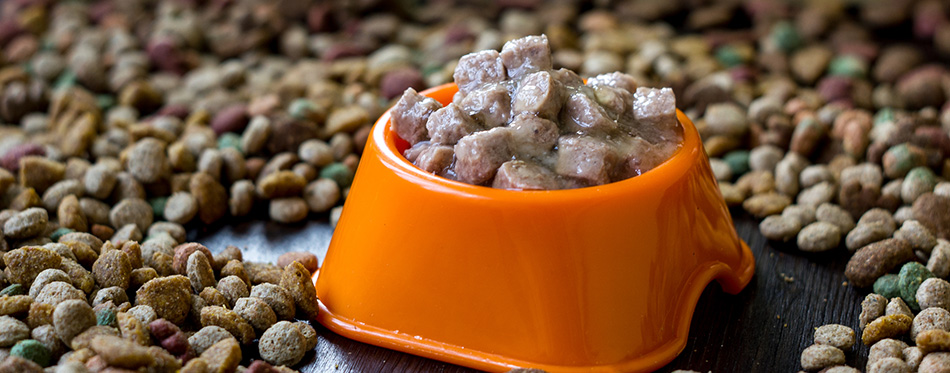The very wide choice of dog food can be a little overwhelming, especially for new dog owners. Obviously, you want to do what is best for your pooch in terms of their health and nutrition but there are other factors that need to be balanced into the equation such as cost, convenience and your dog’s own taste preferences.
If you are feeling unsure about what to feed your pup or adult dog, your vet will always be happy to offer you some advice. It is especially important to consult a vet if your dog is very young, very old or has a long-term health condition.
Here is a quick guide on what you should consider when choosing the best food for your pooch.

What You Need to Know About Dog Food in General
You have five basic options when it comes to your dog’s diet. Most owners pick one of them but some like to combine one or more. Any diet that you choose for your dog must be both high-quality and well-balanced. Your aim is to keep your dog healthy with a shiny coat and a strong immune and digestive system.
There are strict laws governing labelling of dog food so get into the habit of reading the ingredients list which is listed by weight. Grains and glutens can cause allergies in some dogs but if your dog is not allergic then you have no reason to avoid them. Some owners prefer to avoid animal by-products such as heart and lungs although they are often highly nutritious sources of protein.
The label should indicate if the food is ‘complete’ or ‘completely balanced’ which means that it will have everything that your dog needs and you don’t have to worry about supplements. Some foods are recommended as the best dog food for puppies or the best dog food for seniors because these two extremes of age have very different nutritional requirements.
Your choices are:
- Dry dog food. You may also see this referred to as kibble. As the name suggests, it is dog food that has had a lot of the moisture removed so it is easy to store.
- Canned dog food. This is moist food that can contain up to 75% water.
- Semi-moist. Usually available in pouches and shaped like a mini pork chop or burgers. They are not nutritionally balanced and should only ever be given as a treat and not as a main food.
- Home-cooked. Some dog owners prefer to prepare their dog’s food from scratch themselves. This is time-consuming but does mean that you know exactly what your pooch is eating. You need to know quite a bit about nutrition to make sure that you are providing them with all the nutrients that they need.
- Raw food. Some owners feel that this is the most natural diet as it consists entirely of raw meat with some raw bones to provide phosphorus and calcium. Dogs are able to digest raw meat but there are both benefits and risks so you should always talk to your vet before transitioning your pet onto this diet.
What You Need to Know About Dry Dog Food
Dry dog food was the first-ever commercially available dog food, introduced more than a century ago. For many years that is what most dogs lived off because there was no other choice (apart from raw meat and bones). A good dry dog food will contain between 18 and 32 percent protein. It will have 8-22 percent fat.
There is no doubt that dry dog food is both the cheapest and most convenient way of feeding your dog. Because it is dry, it can be left for many hours in a feeding bowl for your pooch to come back to as they choose. This is ideal for slow and intermittent feeders. It is easy to store and is a very cost-effective way of feeding your dog as there is little wastage. You can use individual kibbles as rewards for training purposes so you don’t have to buy additional dog treats. They are available in lots of different shapes and sizes so you can experiment to find one that your dog loves. Although, you do have to be aware of the choking hazard that kibble can present. Many are shaped in a particular way to scrape plaque off teeth and gums and this promotes dental health which can be a major concern in dogs. Find out more about slow feeder dog bowls here.
The main disadvantage is that they do not contain much moisture and so it is vitally important that your dog drinks a lot of water with them. Not all dogs will do that and there may be concerns about dehydration. This is a particular concern for older dogs, ill dogs and in hot climates. If you soak the kibble in water before you feed them to your dog, you have got over the moisture problem but lost many of the advantages of dry kibble! It is also true that not all dogs take to them. Many pooches prefer something a bit more moist and with a stronger odor!
What you Need to Know About Wet Dog Food
Wet dog food is more expensive and is not as easy to store. Once you have opened a tin it can go off quite quickly if you don’t cover and refrigerate it. You can’t leave a half-eaten bowl of wet dog food in your home or garden because it will attract vermin, insects and can become contaminated with bacteria which can make your dog ill. Many dogs make a huge mess when they are eating wet food and you may get fed up of clearing it away. You will also need to pay attention to dental hygiene because wet food will not scrape off plaque.
On the plus side, it will provide hydration as well as nutrients to your dog. This is very useful for dogs who do not drink a lot of water. Wet food is always very carefully balanced in terms of nutrition and usually contain very high-quality protein in the form of lean meat. It usually has higher protein and fat content and lower carbohydrate content than dried food. They also contain fewer artificial flavourings and colourings. It does not require as much chewing and is, therefore, suitable for dogs with jaw or dental problems.
Best Dog Food for Puppies
Many owners worry ‘is wet dog food bad for puppies’ and the best person to advise you on the most appropriate dog food for puppies is your vet. They will take your pup’s age, breed and any underlying medical conditions into account. Pups are growing very fast and need the correct balance of nutrients if they are to have strong bones and teeth. They also have huge energy demands because they are so busy exploring and playing. A special diet formulated for growing pups is essential and you should not feed an adult commercial dog food to puppies. This should be clearly labelled on the food container. Pups need a lot of carbohydrates to produce all the energy that they need and dried foods tend to be carbohydrate-rich and so may suit pups well.
In general, pups do well on either dry or wet dog food. Most pups start to show an interest in solid food at around four weeks when they may try out what is in their Mum’s food bowl. This is a good time to start introducing some solid food but they are too young at this stage to cope with dried kibble. Instead, take a small amount of food and mix it up with quite a lot of water until it reaches the consistency of thin porridge. Young pups need three meals a day but this can be reduced to two when your pup reaches six months.
Older pups like to crunch on small kibble but they may find larger pieces too challenging. Their teeth and gums will certainly benefit from eating the dried food. Once you have found a type of kibble that your pup likes, it is best to stick to it because switching diet can cause pups to get nasty stomach upsets.

Best Dog Food for Seniors
Again, the best person to advise you is your vet. Senior dogs are more likely to suffer from long-term health problems which can mean that they need to have a special diet and it is important that you get professional advice about this.
In general, older dogs do better on a wet food diet but there are exceptions to this. Older dogs often lose their sense of taste and smell (olfactory senses) and this can result in a loss of appetite. Wet foods tend to be smellier and tastier and so it may be easier to persuade them to eat it. There is also usually a greater variety of flavours available in wet dog food so you may find it easier to find a variety that appeals to your senior pooch.
Some older dogs are not good at staying hydrated and they need wet food to make sure that they are getting enough moisture.
Senior dogs are more likely to be obese than a young pup who is bounding around the place all day! They need a carefully controlled diet to keep the weight off. Because there is more moisture in wet food, it takes up more volume in the stomach and makes a dog feel fuller even though they have not taken in more calories. This is why wet food usually suits a dieting dog well.
Finally, many older dogs suffer from chronic dental disease and may have teeth missing and sore gums. If the dental disease is well-established, it may be painful for them to eat hard kibble. If they have teeth missing, it may be impossible for them to do so. A wet diet will suit them better.
If you have decided to transfer a senior dog over to a wet diet when they are used to dry food, you must get advice from your vet. Changes in diet can cause stomach upsets in dogs and any changes in diet must be done gradually. An alternative approach would be adding water to dry dog food to make it softer and a bit more palatable for your senior dog.
Making the Right Decision for Your Dog
After taking professional advice, it is up to you to make the right decision for your dog based on their age, breed and health status. You will have to balance this up with your own lifestyle and budget. Whichever you choose, make sure that you pick a brand that is appropriate for your dog’s age and breed. You could choose a wet or dry dog food for puppy health and vitality but you may find that your senior dog prefers a wet diet.
Some owners decide to adopt a feeding method known as ‘topping’ when you feed your dog wet dog food with some kibble sprinkled on top so they get the best of both worlds. Often the practice of mixing wet and dry dog food gives a dog a great variety of textures and flavours that they will enjoy. However, always check with your vet because randomly mixing foods together can result in excessive weight gain or even an overdose of some vitamins and minerals which may do more harm than good.
It is never acceptable to add a ‘topper’ of kibble to therapeutic dog food. If your dog has been put on a therapeutic diet because of a chronic health condition, you must not alter it in any way by adding other things.
Finally, don’t forget that you may not get the last say in this decision. Your dog may have their favorites as well!

